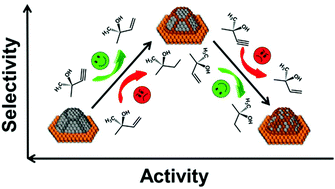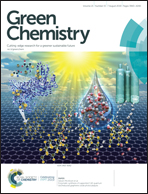Tuning the catalytic performance for the semi-hydrogenation of alkynols by selectively poisoning the active sites of Pd catalysts†
Abstract
Semi-hydrogenation of alkynols to alkenols with Pd-based catalysts is of great significance in fine chemical industries. Industrial Lindlar catalysts, employing Pb to modify the Pd nanoparticles for higher selectivity toward alkenols, however, generally suffer from both a severe activity decrease and environment pollution caused by using heavy metal Pb and additives. Therefore, how to overcome the selectivity–activity paradox remains a great challenge in industry. Here, we report a controllable strategy for the synthesis of semi-hydrogenation catalysts, which successfully improves the catalytic performance through selectively poisoning the edge and corner sites of Pd nanoparticles. When the integrity of the crystal face is reserved, both higher activity (∼1340 h−1) and selectivity (∼95% at 99% conversion) are achieved in the semi-hydrogenation of 2-methyl-3-butyn-2-ol (MBY) in ethanol, an industrially important intermediate product for the synthesis of vitamin E, without adding any toxic additives. What's more, the yield could exceed 98% at 99% conversion under no solvent and organic adsorbate conditions, which had never been achieved before. This work provides a different perspective to design and develop high performance catalysts for semi-hydrogenation of alkenols or even substituted alkynes.



 Please wait while we load your content...
Please wait while we load your content...